Product introduction
Waste tire processing equipment is a large-scale complete set of equipment that can completely separate the three major raw materials contained in tires: rubber, steel wire, and fiber at one time at room temperature and realize recycling.
Display diagram of waste tire processing equipment
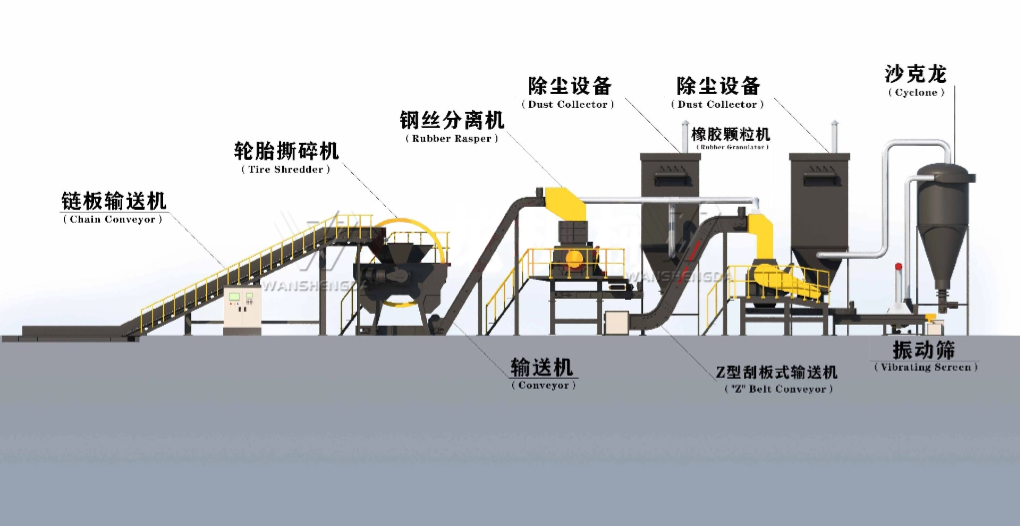
Waste tire processing equipment is a large-scale complete set of equipment that can separate the three raw materials contained in tires: rubber, steel wire, and fiber at one time at room temperature and achieve high recycling. The process is perfect and the production efficiency is high. The waste tire processing production line can recycle tires with a diameter range of 400-3000mm according to customer requirements. It has strong applicability, the output size can be controlled within the range of 5-100mm, and the output can reach 200-10000kg/h. The production line operates at room temperature, does not require any chemical additives, and will not cause secondary pollution to the environment. The production line adopts a PLC control system, which is easy to operate and maintain, and has the characteristics of low energy consumption and long service life.
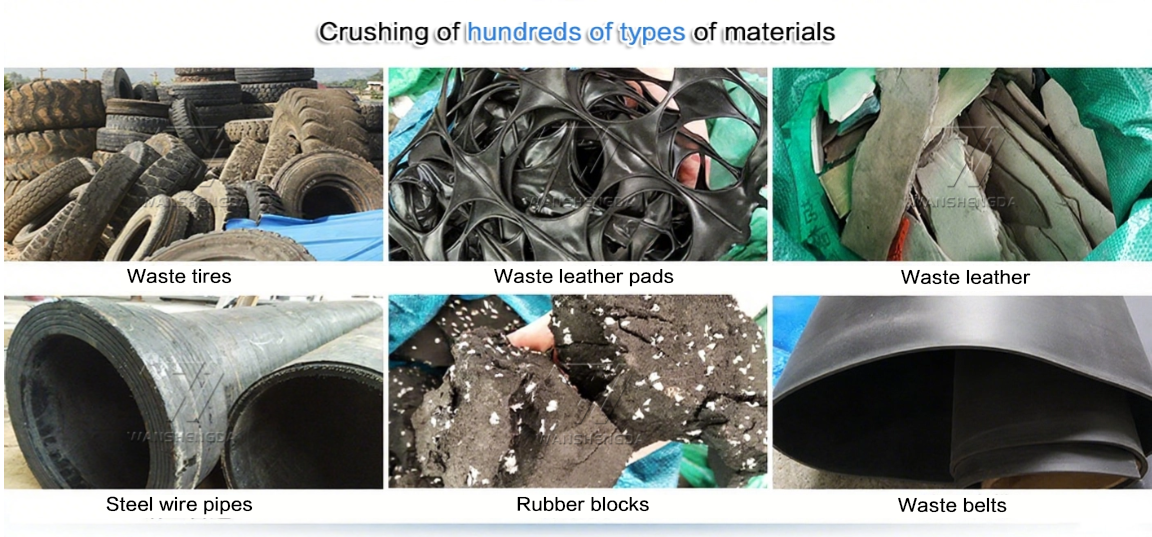
Main equipment:
Depending on the different tire characteristics and productivity requirements, the equipment may include:
1.Fully automatic wire drawing machine: removes tire rims.
2.Conveying equipment: conveyor belts, screw conveyors and air pressure transmission systems.
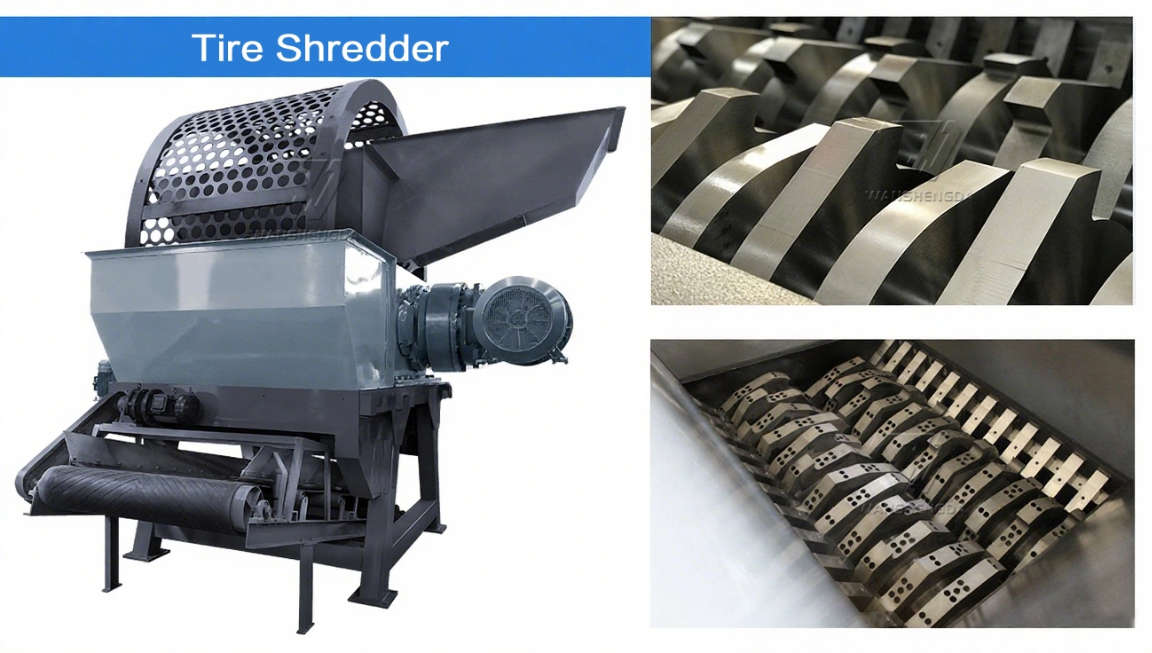
3. Tire shredder: shreds tires into rubber sheets (50mm-150mm).
4. Steel wire separator: separates rubber and steel wire and processes them into rubber particles (10mm-20mm).
5. Magnetic separator: separates steel wire from rubber and steel wire mixture.
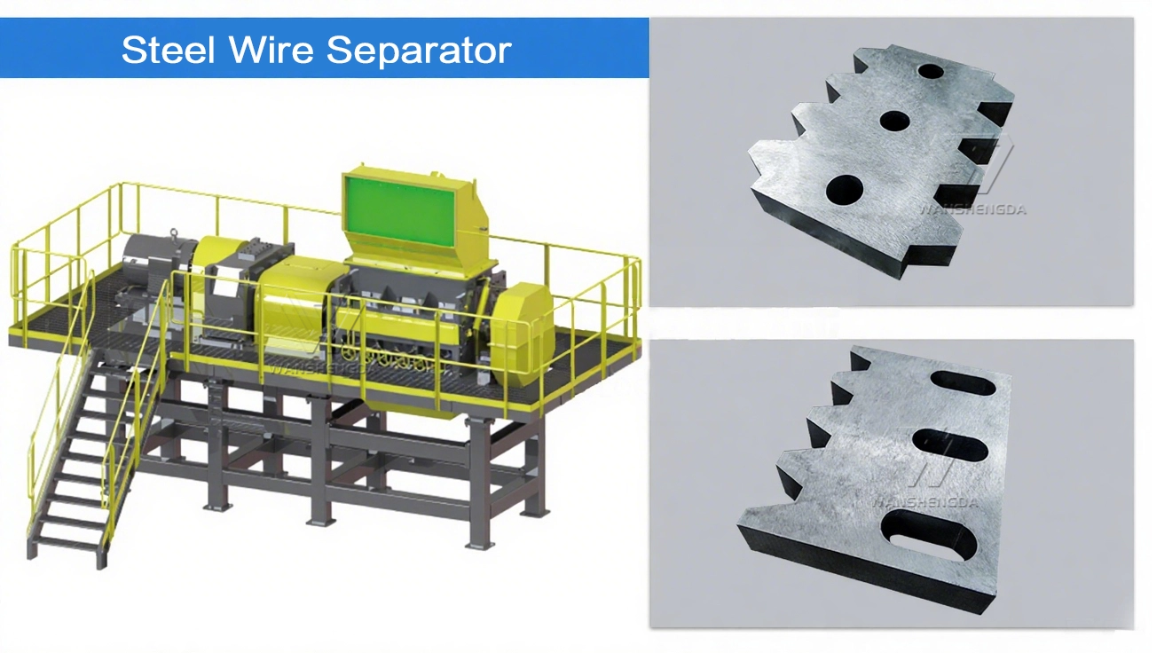
6. Rubber granulator: crush the rubber particles to smaller size (1mm-7mm).
7. Vibrating screen: sort rubber particles of different sizes, and send oversized particles back to the crusher for secondary crushing.
8. Fiber separator: remove foreign matter and fibers.
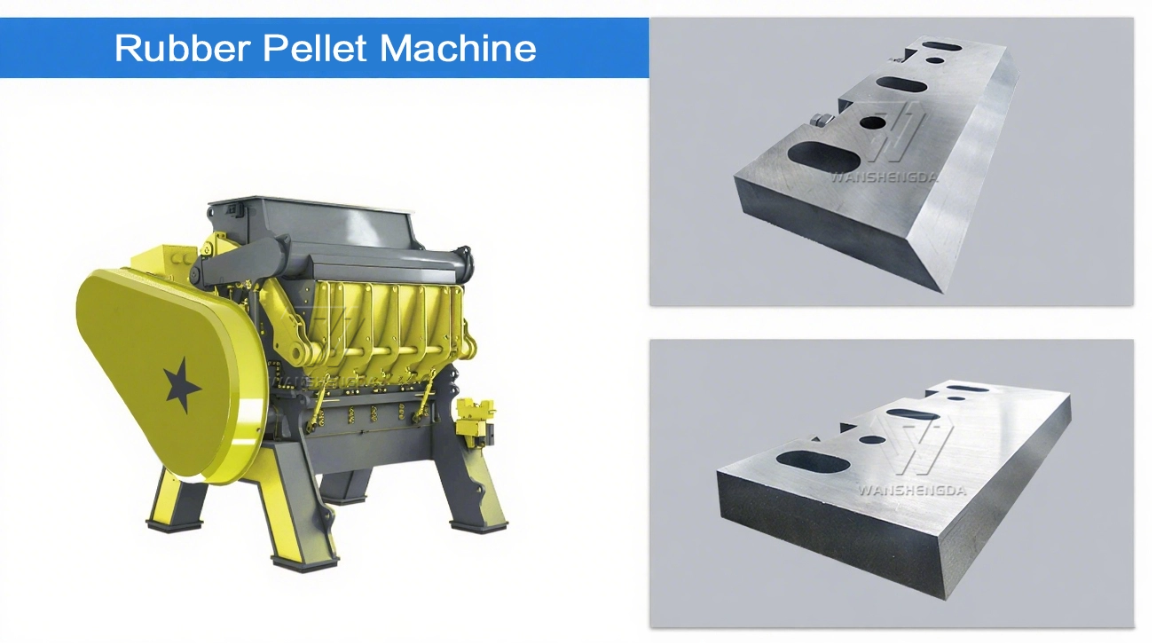
9. Secondary magnetic separator: removes any remaining fine steel wire.
10. Grinding mill: grinds particles into powder (30 mesh - 100 mesh).
11. Fully automatic bagging system: packs finished products into storage bags or packaging bags.
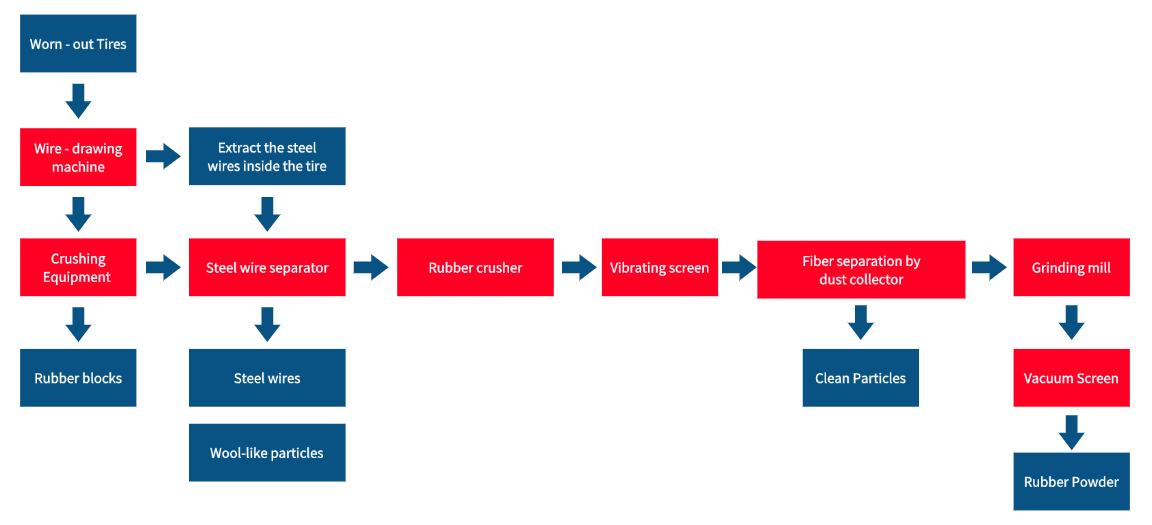
This equipment is a supporting equipment in the whole set of tire recycling equipment production line. It can be matched according to the special requirements of users for the finished products. After matching, the fineness of the finished product can reach 120 mesh, which can be adjusted according to the fineness requirements.
Features of the production line:
1. The whole tire is directly put in, without the need for pre-crushing and steel ring pulling.
2. From the whole tire to 1-7mm particles, the whole process of production and packaging, there is no secondary handling intermediate link.
3. The processing capacity reaches 5000kg/h, and only 7 people are needed to complete all on-site operations.
4. The equipment model is configured according to the customer's production requirements, 200kg/h-10000kg/h, with a wide range of choices.
5. The fully combined two-layer structure makes installation, replacement, and maintenance more convenient.
6. Seamless connection, full dust and smoke monitoring.
7. Adhere to the 80-100 hours of feeding experiment before the single machine leaves the factory to ensure stable performance.
8. CE certification, unified standards, and focus on technology.
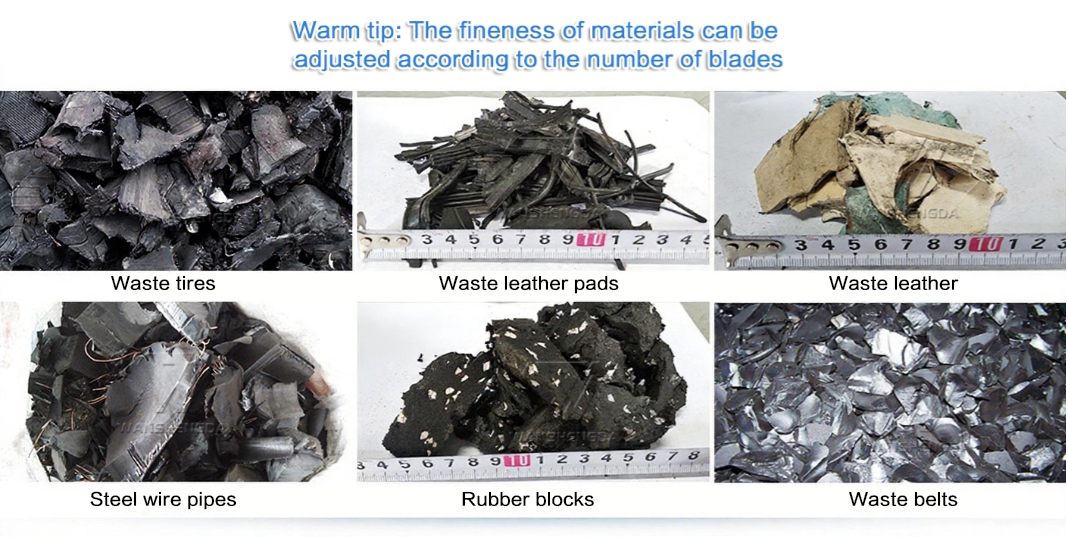
Product advantages:
Bearing design: The reinforced design and half-open structure make maintenance easier. Equipped with dustproof baffles to extend the service life of bearings
Screen design: Control the size of the material. By feeding it into the shredder for repeated shredding, the output is controlled within the specified size range
Body design: The blade is strong and wear-resistant, and the blade arrangement and bite method are specially designed for waste tires.
Power design: It adopts a reduction motor drive, which saves time, effort and electricity, and has strong power.
Environmental design: The equipment has the characteristics of low speed, high torque, low noise, and dust that can meet environmental protection standards.
Waste tire treatment methods
Production of recycled rubber
Reproduction of tires. Desulfurizing waste tire rubber through chemical methods to obtain rubber is an ancient method of comprehensive utilization of waste tires. The current production technology used to process waste tires for recycling is a reasonable, scientific and widely used way, and is adopted by countries around the world.

Production of vulcanized rubber powder
The powder production industry has great development potential. Since it is processed by pure physical methods, there is no waste gas and wastewater pollution in the production, and the resource utilization rate is very high. It is a recognized method for recycling and harmless processing of waste tires.

Paving with waste tires
New technology, new life. Waste tires used for paving roads are called rubber asphalt. This new method of recycling waste tires originated in the United States in the 1960s - processing waste tires into rubber powder and adding it to asphalt as a modifier.

Solid waste fuel
The embodiment of light and heat. Waste tires are a high calorific value material, with a calorific value per kilogram that is 69% higher than wood, 10% higher than bituminous coal, and 4% higher than coke. The waste tires are crushed and then mixed with various combustible waste materials in the required proportion to make solid waste fuel (RDF), which can be injected into blast furnaces to replace coal, oil and coke as a fuel for burning cement or to replace coal and thermal power generation. At the same time, this method also produces a by-product - carbon black, which can be used as a reinforcing agent in rubber product production after activation.

Waste tire oil refining
Waste tire oil refining equipment converts waste tires into 45-52% pyrolysis oil, 30%-35% carbon black and 10-15% steel wire through high temperature pyrolysis. These pyrolysis oils can be used in heavy industries such as cement plants, glass plants, boiler plants, etc. Carbon black can be used in cement plants and pressed into balls for sale.
Cracking waste tires
is one of the main ways to convert them into energy and non-rubber resources. The main methods include catalytic pyrolysis, high and low temperature pyrolysis. Waste tires can be used to extract steel, carbon black, oil, gas, etc. at high temperatures. 35 kg of carbon black and 55 kg of fuel oil can be recovered from one ton of waste tires.
| Model |
Spindle power (kw) |
Spindle speed (r/min) |
Output (t/h) |
Conveyor power (kw) |
Number of cutter discs (pieces) |
Cutter disc diameter (m/m) |
Crushing size (am) |
Binyard size (m) |
Length, width and height (m) |
Weight (t) |
| WSD-2600 |
4-160*2 |
16-18 |
25-60 |
4-3kw |
40 |
Ø720 |
3-10 |
2.5*14 |
8 2*4*4 3 |
36 |
| WSD-1900 |
4-90*2 |
14-16 |
10-25 |
4-3kw |
40 |
Ø560 |
3-10 |
23*2 |
8*2.5*2.4 |
15 |
| WSD-1500 |
4-45*2 |
14-16 |
8-18 |
4-3kw |
30 |
Ø530 |
3-10 |
2*2 |
4*1.7*2.4 |
12 |
| WSD-1200 |
4-37*2 |
18-20 |
6-15 |
None |
28 |
Ø372 |
3-10 |
14*1 |
3.2*2*1.9 |
6 |
| WSD-1000 |
4-30*2 |
18-20 |
5-10 |
None |
30 |
Ø360 |
3-10 |
1.2*1 |
3*2*19 |
5 |
| WSD-600 |
4-15*2 |
18-20 |
2-5 |
None |
26 |
Ø260 |
3-10 |
0.82*0.9 |
2.6*2*1.9 |
2.5 |













